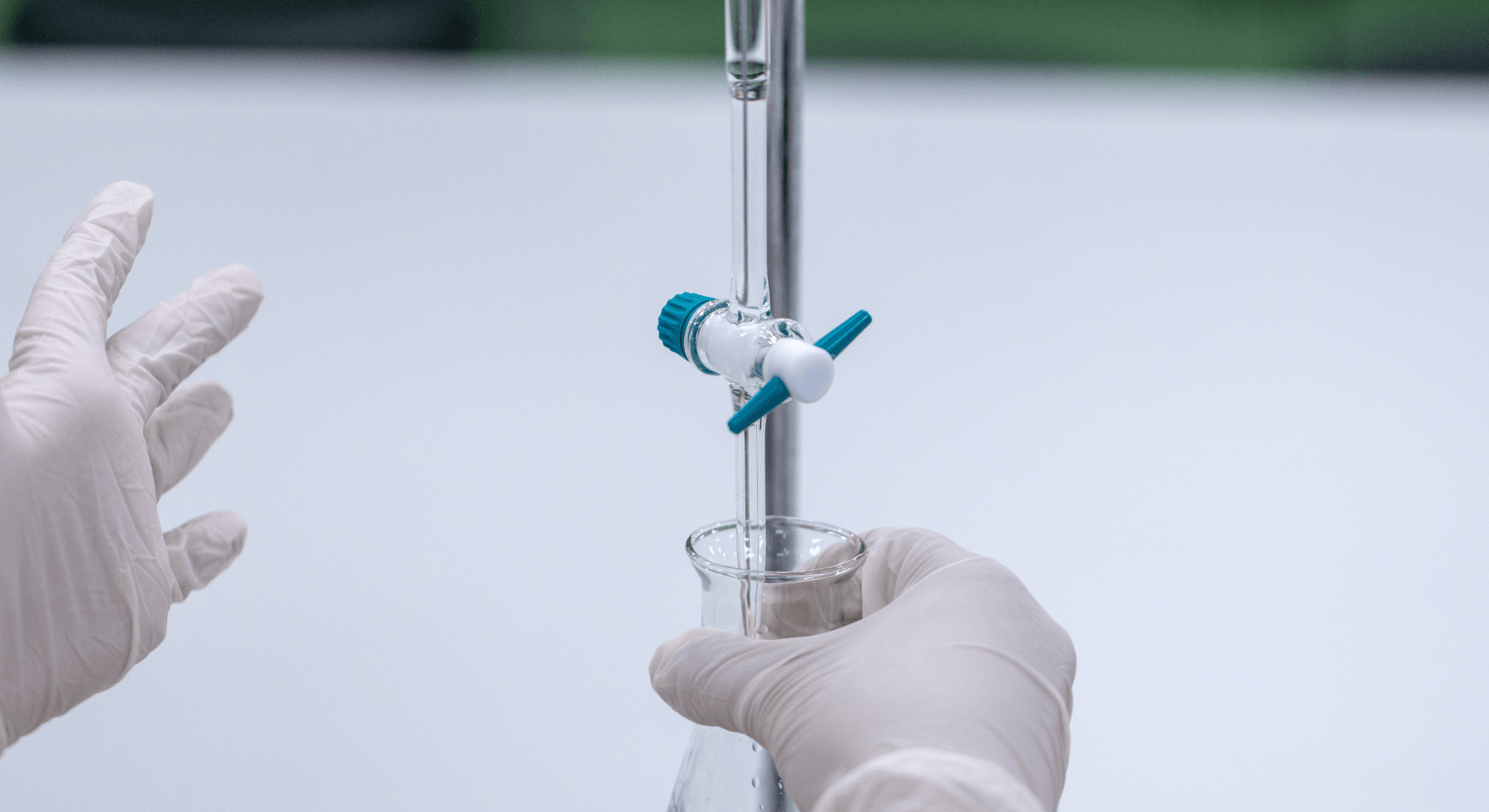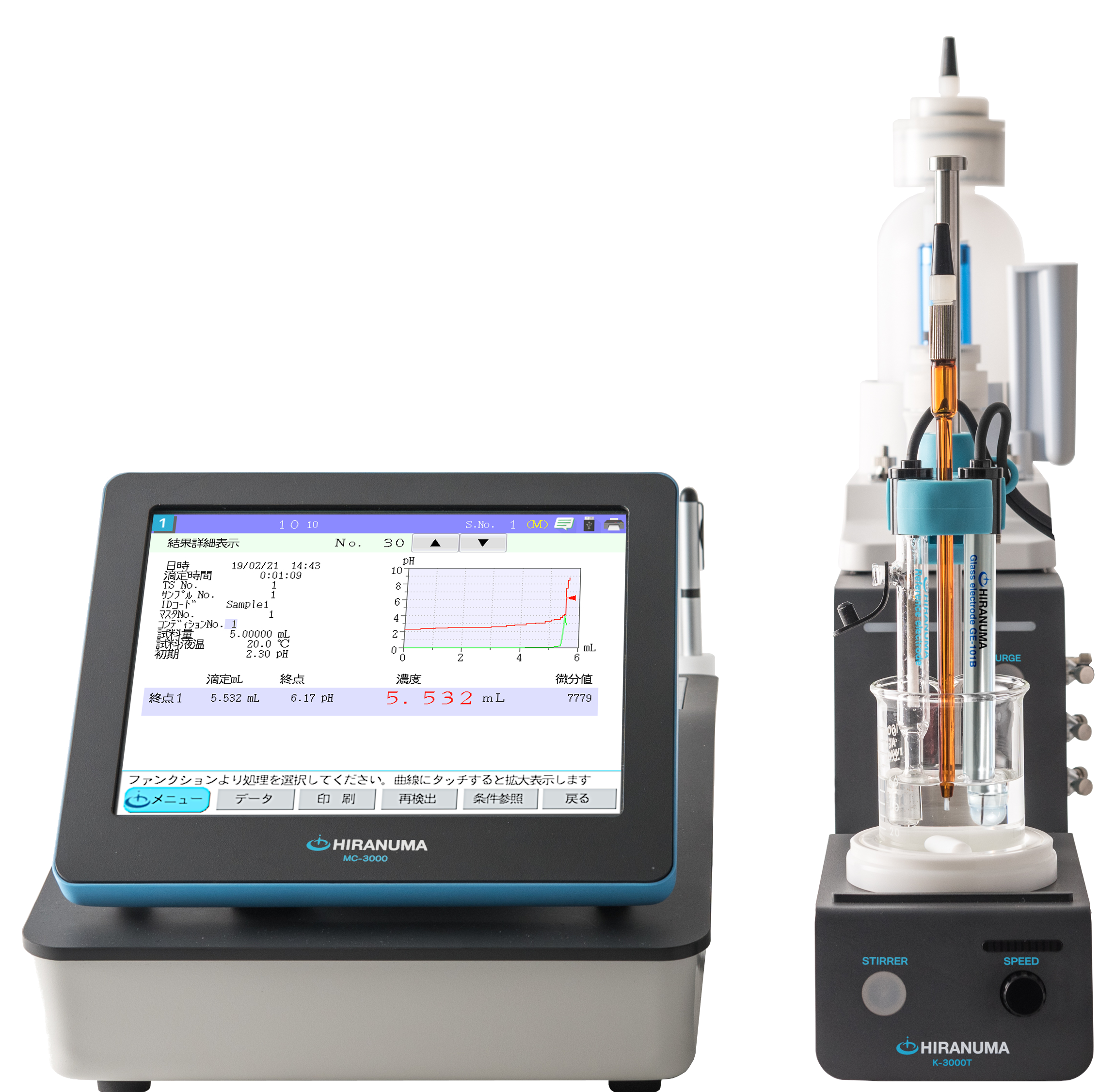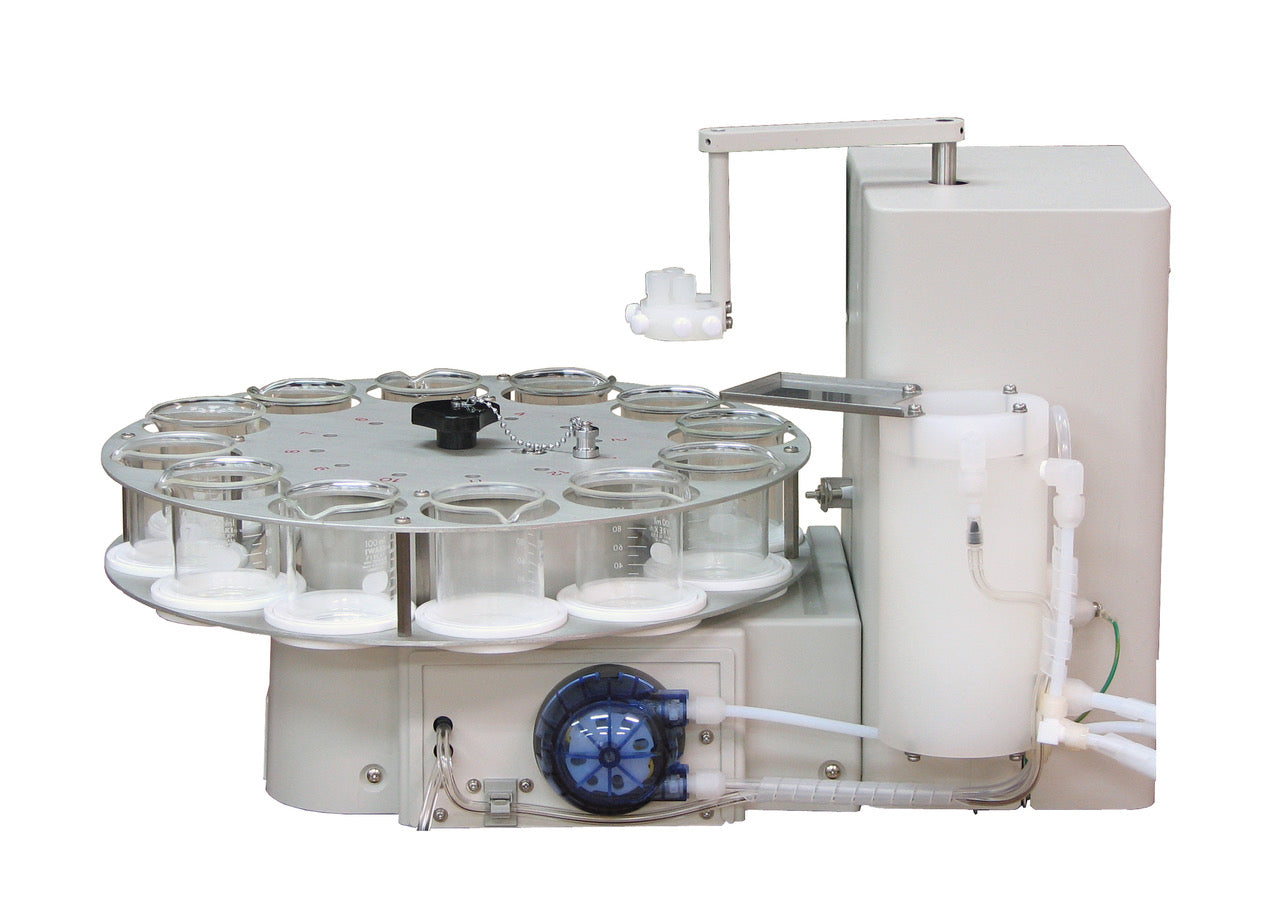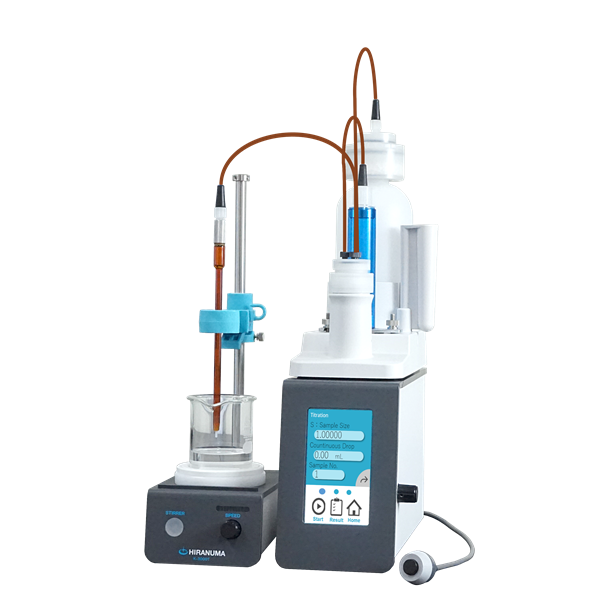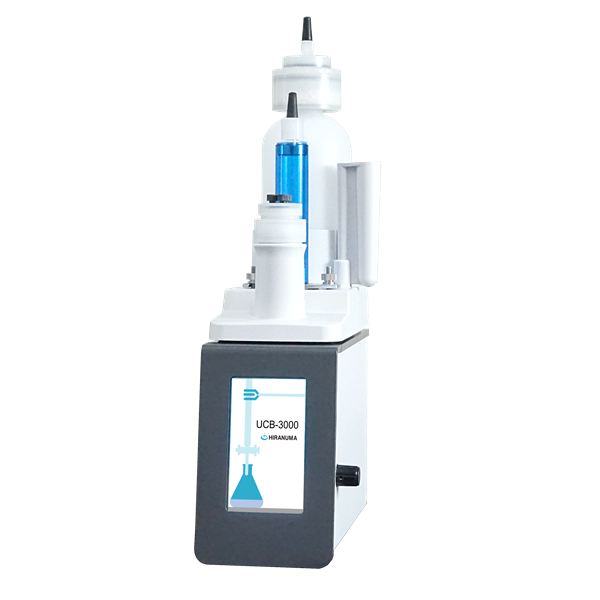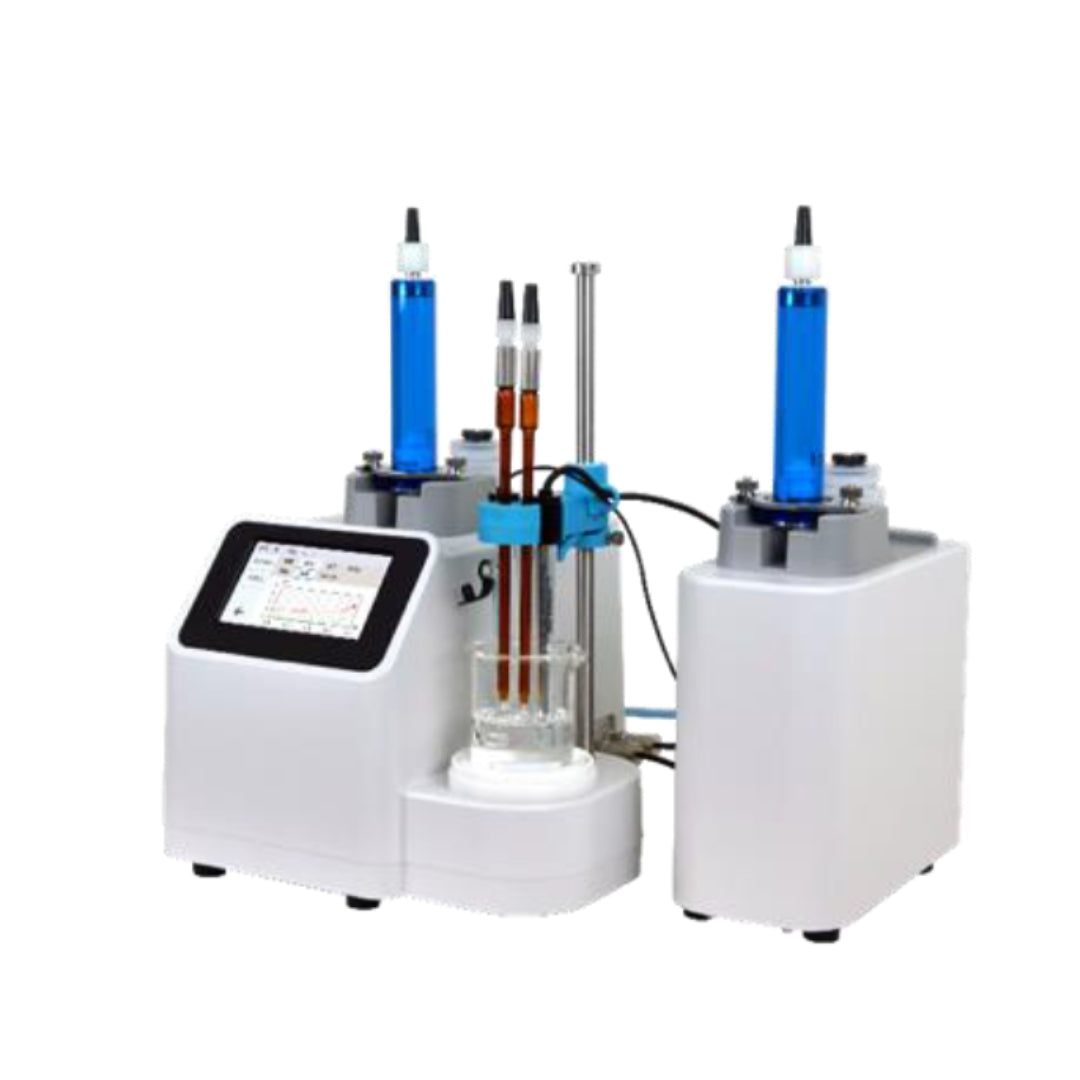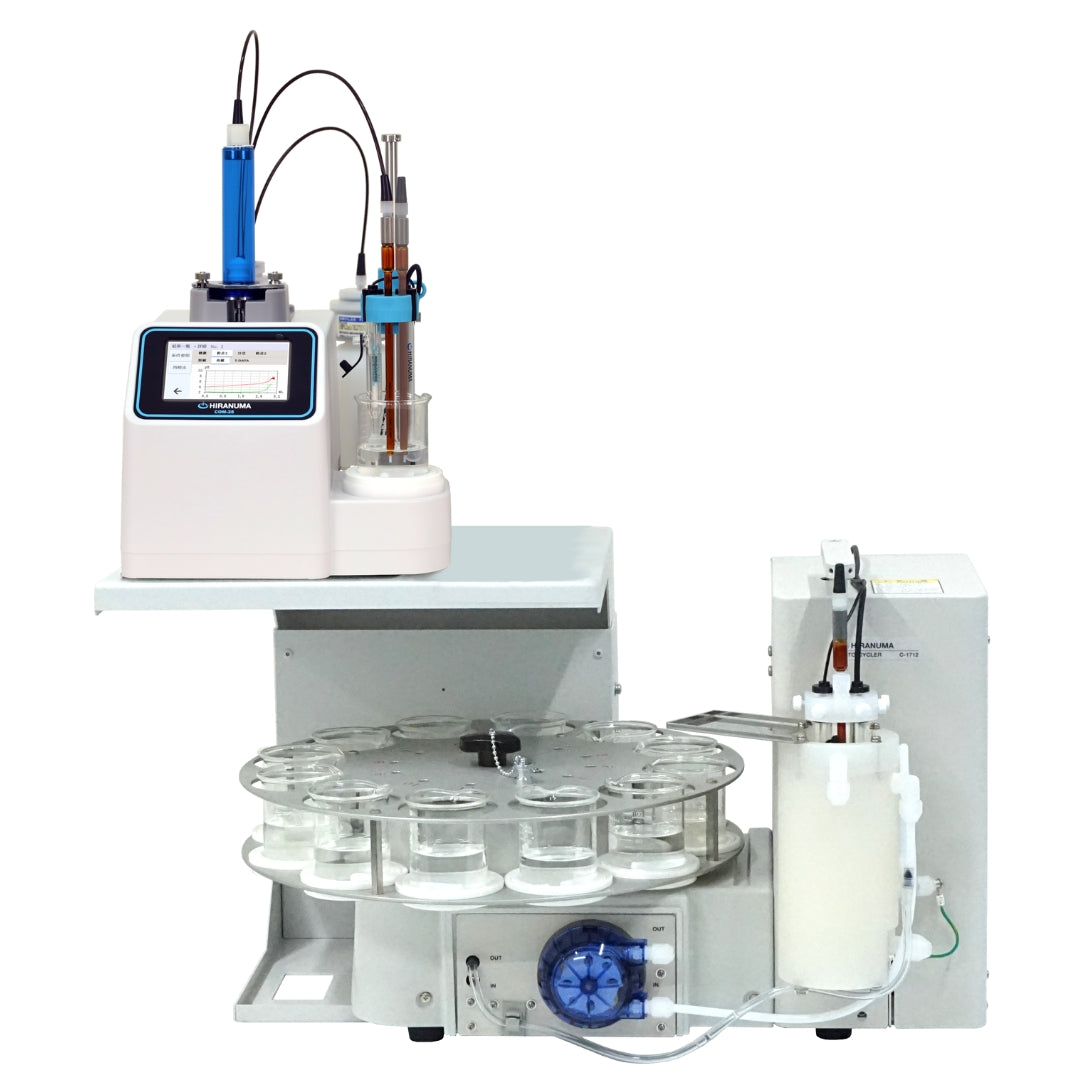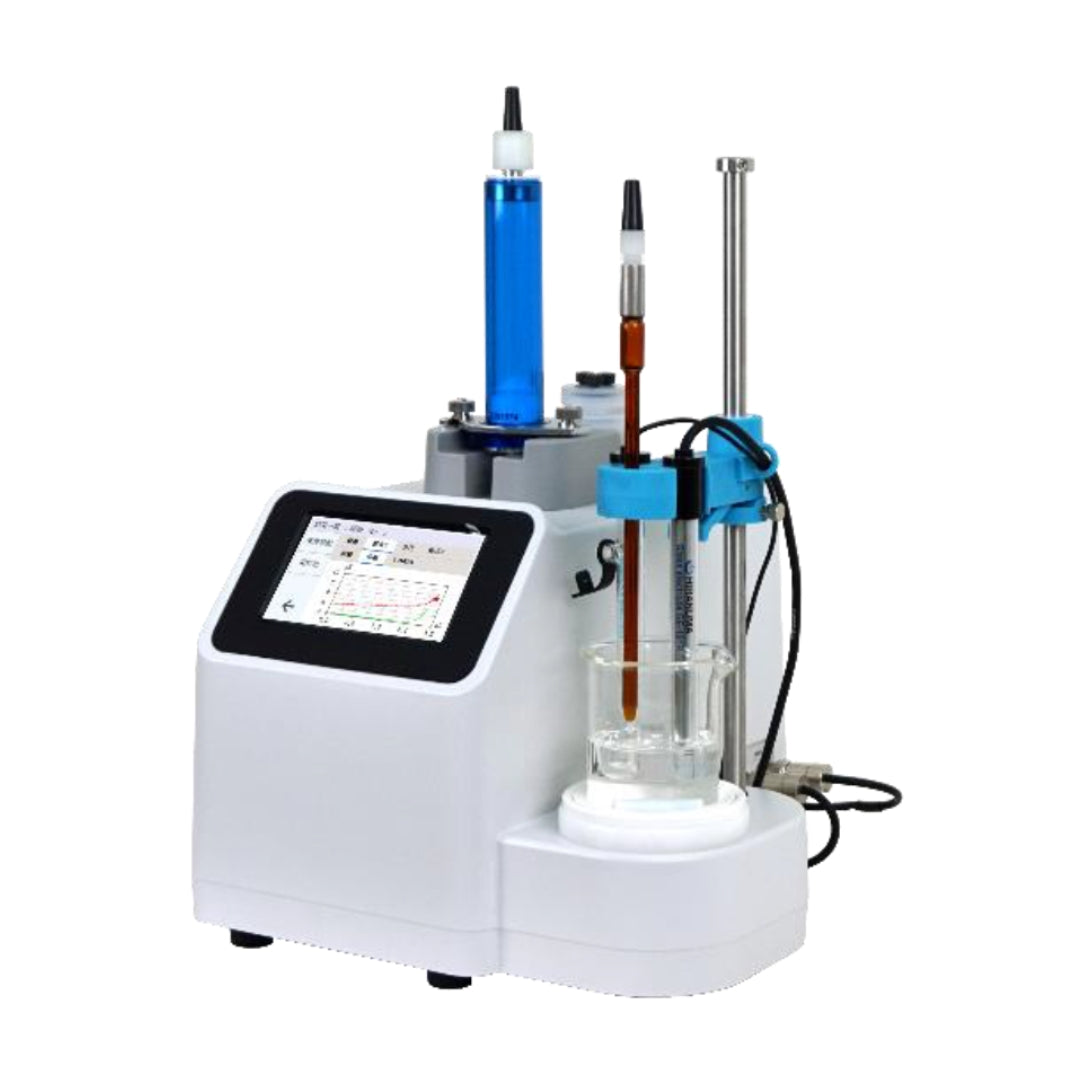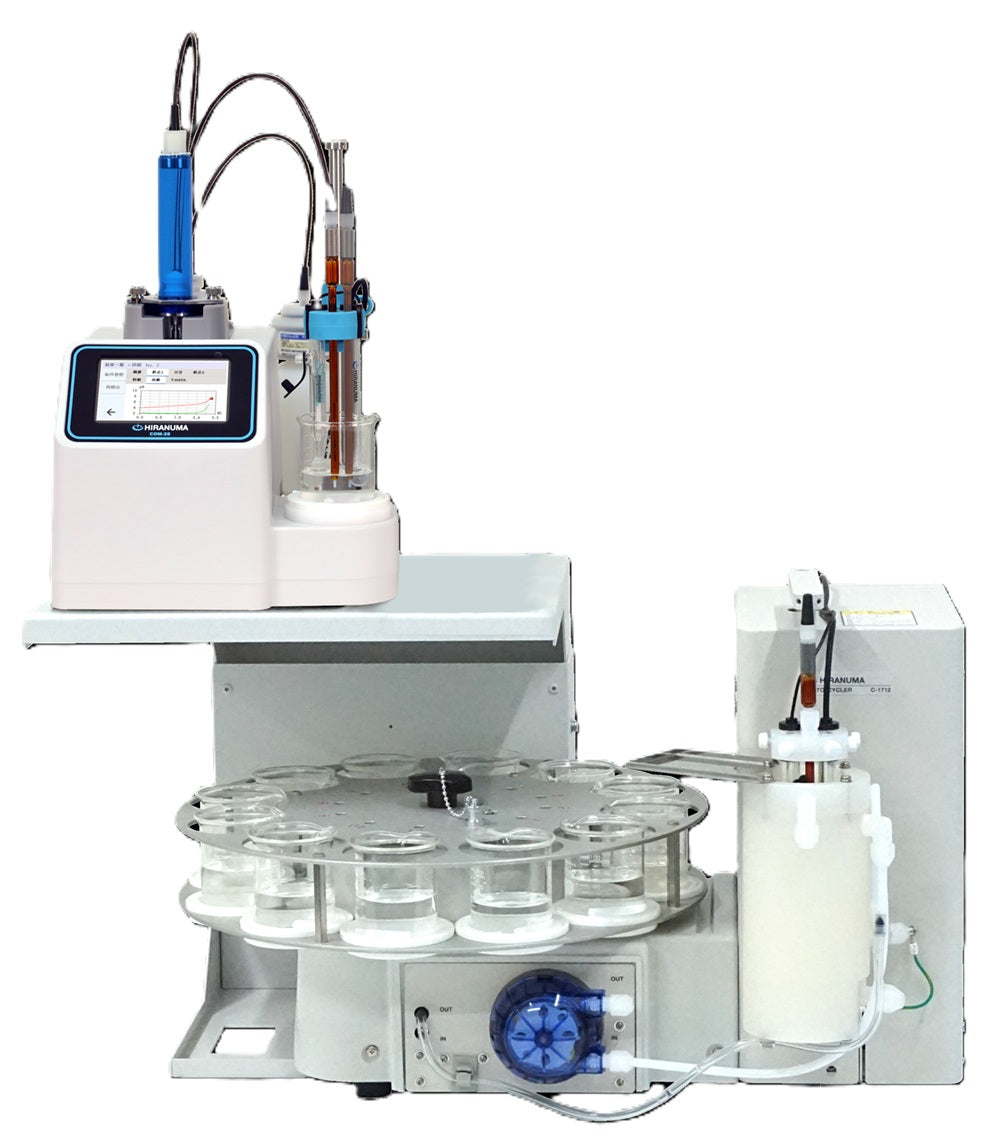| HIRANUMA APPLICATION DATA | Automatic Titrator | Data No. | K5 | Jul. 14,2020 |
| Organic acid | Purity determination of oxalic acid |
1. Abstract
Oxalic acid has two carboxy groups (-COOH) in the molecule , it is called dicarboxylic acid. There are two crystallization water molecules in the molecule. Oxalic acid is ortho acid and forms the following structure. It is readily oxidized by the acid stronger than formic acid.


2. Configuration of instruments and Reagents
(1) Redox titration with potassium permanganate
| (i) | Configuration of instruments | ||
| Main unit | : | Hiranuma Automatic Titrator COM series | |
| Electrode | : | Platinum electrode PT-301 Reference electrode RE-201Z *Instead of the above electrodes, the following electrodes are usable. ・Platinum reference combination electrode PR-701BZ |
|
| (ii) | Reagents | ||
| Titrant | : | 0. 02 mol/L Potassium permanganate standard solution | |
| Additive | : | Diluted sulfuric acid (1:1, [v/v]) | |
(2) Neutralization titration with sodium hydroxide
| (i) | Configuration of instruments | ||
| Main unit | : | Hiranuma Automatic Titrator COM series | |
| Electrode | : | Glass electrode GE-101B Reference electrode RE-201Z *Instead of the above electrodes, the following electrodes are usable. ・Glass reference combination electrode GR-501BZ…Fixed sleeve type ・Glass reference combination electrode GR-511BZ…Moveable sleeve type |
|
| (ii) | Reagents | ||
| Titrant | : | 1 mol/L Sodium hydroxide standard solution | |
3. Measurement procedure
| (1) | Redox titration with potassium permanganate | ||
| (i) Take 0.2 g of sample into a 300 mL beaker and weigh accurately with 0.1 mg digit. | |||
| (ii) Add stirring bar and 200 mL of DI water and 20 mL of diluted sulfuric acid. | |||
| (iii) Dispense 30 mL of 0.02 mol/L potassium permanganate with stirring solution. | |||
| (vi) Heat the beaker at about 60 °C. | |||
| (v) Immerse electrodes and start titration with 0.02 mol/L potassium permanganate standard solution. Perform the blank test in the same procedure without sample and procedure (iii). |
|||
| (2) | Neutralization titration with sodium hydroxide | |
| (i) Take 1.0 g of sample into a 100 mL beaker and weigh accurately with 0.1 mg digit. | ||
| (ii) Add stirring bar and 50 mL of DI water. Dissolve the sample by stirring. | ||
| (iii) Immerse electrodes and start titration with 1 mol/L sodium hydroxide standard solution. | ||
4. Measurement conditions and results
(1) Redox titration with potassium permanganate standard solution
Examples of titration conditions
(i) Measurement of blank
| Cndt No | 1 | |
| Method | Auto | |
| Buret No. | 1 | |
| Amp No. | 2 | |
| D. Unit | mV | |
| S-Timer | 5 | sec |
| C.P. mL | 0 | mL |
| T Timer | 0 | sec |
| D.P. mL | 0 | mL |
| End Sens | 100 | |
| Over mL | 0.3 | mL |
| Max Vol. | 20 | mL |
| Constant No. | 1 | |
| Size | 0 | g |
| Blank | 0 | mL |
| Molarity | 0.02 | mol/L |
| Factor | 1.003 | |
| K | 0 | |
| L | 0 | |
| Unit | mL | |
| Formula | D | |
| Decimal Places | 3 | |
|
Auto input Param.
|
Non | |
| Mode No. | 18 | |
| Pre Int | 0 | sec |
| Del K | 0 | |
| Del Sens | 0 | mV |
| Int Time | 5 | sec |
| Int Sens | 5 | mV |
| Brt Speed | 2 | |
| Pulse | 40 |
(ii) Dispense 0.02 mol/L potassium permanganate standard solution.
| Cndt No | 2 | |
| Method | Disp | |
| Buret No. | 1 | |
| S-Timer | 5 | sec |
| Disp Vol. | 30 | mL |
| Cndt No | 3 | |
| Method | Auto | |
| Buret No. | 1 | |
| Amp No. | 2 | |
| D. Unit | mV | |
| S-Timer | 10 | sec |
| C.P. mL | 0 | mL |
| T Timer | 0 | sec |
| D.P. mL | 0.1 | mL |
| End Sens | 500 | |
| Over mL | 1 | mL |
| Max Vol. | 20 | mL |
| Constant No. | 3 | |
| Size | 0.2 | g |
| Blank | 0.074 | mL |
| Molarity | 0.02 | mol/L |
| Factor | 1.003 | |
| K | 126.07 | |
| L | 2.5 | |
| Unit | % | |
| Formula | ||
| (D+30-B)*K*F*M*L/(S*10) | ||
| Decimal Places | 3 | |
|
Auto input Param.
|
Non | |
| Mode No. | 22 | |
| Pre Int | 0 | sec |
| Del K | 0 | |
| Del Sens | 0 | mV |
| Int Time | 5 | sec |
| Int Sens | 5 | mV |
| Brt Speed | 2 | |
| Pulse | 40 | |
* Enter the blank value to “B”, the molecular weight of oxalic acid dehydrate to “K”, and the reaction ratio between oxalic acid dihydrate and potassium permanganate to “L”.
Measurement results
| Number of measurement |
Size (g) |
Titrant volume(mL) |
|---|---|---|
| 1 | – | 0.073 |
| 2 | – | 0.074 |
| Avg.(Blank) | 0.074 mL | |
Examples of titration curves

Measurement results
| Number of measurement |
Size (g) |
Titrant volume(mL) |
Purity (%) |
|---|---|---|---|
| 1 | 0.2007 | 1.779 | 99.876 |
| 2 | 0.2017 | 1.976 | 99.999 |
| 3 | 0.2012 | 1.876 | 99.933 |
| Statistic calculation |
Avg. | 99.94 % | |
| SD | 0.0616 % | ||
| RSD | 0.0616 % | ||
Examples of titration curves

(2) Neutralization titration with 1 mol/L sodium hydroxide standard solution
Examples of titration conditions
(i) Measurement of oxalic acid dihydrate
| Cndt No | 4 | |
| Method | Auto | |
| Buret No. | 1 | |
| Amp No. | 1 | |
| D. Unit | pH | |
| S-Timer | 5 | sec |
| C.P. mL | 0 | mL |
| T Timer | 0 | sec |
| D.P. mL | 0 | mL |
| End Sens | 1000 | |
| Over mL | 0.3 | mL |
| Max Vol. | 20 | mL |
| Constant No. | 4 | |
| Size | 1 | g |
| Blank | 0 | mL |
| Molarity | 1 | mol/L |
| Factor | 1.005 | |
| K | 126.07 | |
| L | 2 | |
| Unit | % | |
| Formula | ||
| (D-B)*K*F*M/(S*10*L) | ||
| Decimal Places | 3 | |
|
Auto input Param.
|
Non | |
| Mode No. | 8 | |
| Pre Int | 0 | sec |
| Del K | 5 | |
| Del Sens | 0 | mV |
| Int Time | 5 | sec |
| Int Sens | 3 | mV |
| Brt Speed | 2 | |
| Pulse | 40 | |
* Enter the molecular weight of oxalic acid dihydrate to “K”, and the valence of oxalic acid dihydrate to “L”.
Measurement results
| Number of measurement |
Size (g) |
Titrant volume(mL) |
Purity (%) |
|---|---|---|---|
| 1 | 1.0067 | 15.874 | 99.893 |
| 2 | 1.0024 | 15.822 | 99.993 |
| 3 | 1.0001 | 15.775 | 99.925 |
| Statistic calculation |
Avg. | 99.94 % | |
| SD | 0.0511 % | ||
| RSD | 0.0511 % | ||
Examples of titration curves

5. Note
(1) Measurement result
The purity of oxalic acid was determined by the following two method: redox titration with potassium permanganate and neutralization titration with sodium hydroxide. There is no difference between the results on these methods, the titration was possible without problem in each method. The neutralization titration is particularly easy because of no pretreatment and the less waste solution.
(2) Collection of sample
The sample is collected directly to the beaker and weighed accurately. The accuracy of sample collection influences the measurement accuracy. Please note that the sample should be carefully taken and accurately weighed.
(3) Control of titrant
The concentrated sodium hydroxide standard solution is used as titrant in this report. The carbon dioxide gas absorber (soda lime) on reagent bottle has to be regularly exchanged because sodium hydroxide readily absorbs carbon dioxide gas in the air (formula (3)). The standard solution of sodium hydroxide that has absorbed carbon dioxide contains sodium carbonate, and the inflection point on titration curve may be unclear due to buffer capacity of sodium hydrogen carbonate generated in the reaction with an acidic sample (formula (4)).
Keywords: Oxalic acid, Potassium permanganate, Sodium hydroxide, Redox, Neutralization, JIS K8519
*Some measurement would not be possible depending on optional configuration of system.

